A Brief Overview of Types of Rope
Before you spend a lot of money on any type of rope, it’s a good idea to explore a little and figure out the style of rope work you want to pursue and the preferences you might have. Which means, it’s best to try out lots of different kinds of rope when possible … usually by finding people who will let you check out the ropes they use!
What to buy first …
While you’re figuring out the kind of rope that’s best for you to invest in, you can also buy some cheap rope just to start learning. Most hardware stores have a decent variety for not much money. Try to get something flexible and not too thick … 4-6mm (about 1/4″) and between 25 – 30 feet in length. We actually recommend cotton clothesline for your first purchase: it’s cheap and easy to work with. (Note that you can often buy 50 ft. pieces that you can cut in half and get two ropes from!) You can start learning some basic knots and cuffs with that until you’re ready to make the harder decisions.
Finding other rope to buy …
When you are ready to buy, “The Rope List” is a very comprehensive list of vendors that is updated regularly.
A Guide to Selection
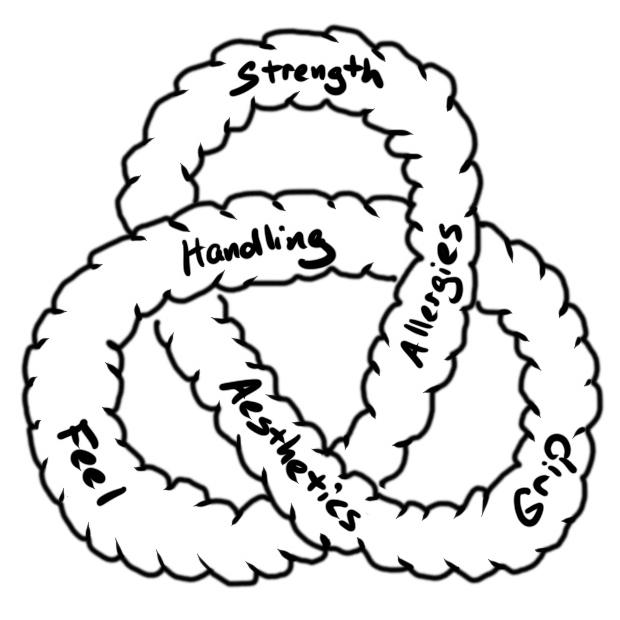
Just because everyone at your local rope group is using “rope type x” doesn’t mean you need to use it. You should carefully weigh the pros and cons of the various options, try to actually handle and tie with some examples, consult with your tying partners, and make informed decisions. Some specific things to consider:
- Strength – Does the strength of the rope matter to you? If you don’t plan on doing suspension work, it may not be a factor. [Note: thicker rope is stronger rope.]
- Grip – How do you feel about the grip and knotting characteristics? Rope that grips on itself really well is great for holding frictions, but that sometimes means it’s also difficult to untie. If a knot gets stuck, how calmly are you able to deal with that? Do you mind cutting your rope? (Hint: you shouldn’t where safety is involved!) [Note: thicker rope can sometimes reduce grip in practical terms.]
- Handling – Do you like how it handles and feels in your hands? For tops, this will be important, but can be a very subjective characteristic. Think of terms like: heavy / light, springy / floppy, supple / stiff, etc. [Note: thicker rope can be less pliant and more difficult to handle.]
- Feel – Do you like how it feels on your skin and around your body? For tops, this will mainly affect wear-and-tear on your hands. For bottoms, this will likely be important everywhere … and probably matters more! Some bottoms prefer rope that feels soft and comfortable, some enjoy the bite of harder, scratchier rope. Some can’t stand the “industrial” feel of MFP, some break out in hives from jute. Speaking of …
- Allergies – Are you or your partners allergic to it? This is important to know before you have someone wrapped up in the stuff! People with grass allergies probably won’t want to tie with jute or hemp, for example.
- Aesthetics – Do you like how it looks? While this may seem trivial, this can actually matter a lot to some tops and bottoms, particularly if they practice decorative bondage or enjoy taking photographs of their rope work.
Materials
In the bondage world, rope falls into two main categories: synthetic or natural fiber. The types of rope you’ll likely see most often are hemp and jute (natural fiber) or nylon (synthetic), though there’s a wide range of others.
Natural-Fiber Rope
Natural-fiber rope in general tends to be weaker and less durable than synthetic rope, but usually offers better grip, easier handling, and less chance for rope burn. In addition, natural-fiber tends to have a lot of variation in its construction, so its strength and durability can vary widely depending on the source and manufacturer. If you advance beyond Rope 101 and eventually decide you want to practice suspension, you will need to carefully weigh the pros and cons of using natural-fiber rope for that purpose given its weaker nature.
- Hemp (medium strength – 400-500*): soft, knots easily, easier to care for than jute, slightly stronger than jute
- Linen (medium strength, similar to hemp): softer than hemp, knots fairly easily, machine-washable
- Jute (weak – 200-300*): springier and lighter than hemp and linen, knots well, unties well, difficult to care for (though many use it for suspension, many others argue against this due to its weakness and the inherent variability depending on construction)
- Cotton (weak to medium strength, but varies by make): soft, knots easily, but is difficult to untie; not recommended for suspension due to its knotting (and stretch for some makes, though this can vary widely); cheaper cotton is very weak
- Bamboo/Rayon and Silk (medium strength, similar to hemp): typically the softest of the ropes (so, good for bedroom bondage), knots easily, but the stretch makes it unsuitable for suspension; also expensive
- Sisal, Manila (weak, similar to jute): rough and scratchy, good for sadistic play, but not for loading at bondage diameters
- Coconut (weakest): rough and scratchy, good for sadistic play, but easily breakable and not suited for other purposes
* All ratings are approximate, given in pounds of force at 6mm. Natural fiber ropes are typically not rated for load/breaking strength, so use at your own risk. Carefully inspect and test natural-fiber ropes and use only with informed consent of all parties.
Synthetic Rope
Synthetic rope’s biggest advantage is its strength and durability. Synthetic rope also tends to be easier to clean and care for. However, it also tends to be more difficult to work with because it doesn’t usually hold frictions as well, can be slippery or stiff, and more easily causes rope burn.
- Nylon (very strong – 1200-1500*): soft, little grip, stretchy, can be dyed, machine-washable [note: because of how slippery nylon can be, we typically don’t recommend this for beginners]
- MFP/Polypropylene (strong – 1100-1300*): can be stiffer than nylon, less stretch, little grip, floats in water, can’t be dyed at home, UV resistant, machine-washable
- Polyester (strong, similar to MFP): stiffer, less grip, less stretch, machine-washable
- Synthetic “Natural Fiber” [typically sold as Hempex or POSH] (moderately strong – 750-1100*): looks like natural fiber, stiffer, lighter, better grip than other synthetics, machine washable
* All ratings are approximate, given in pounds of force at 6mm.
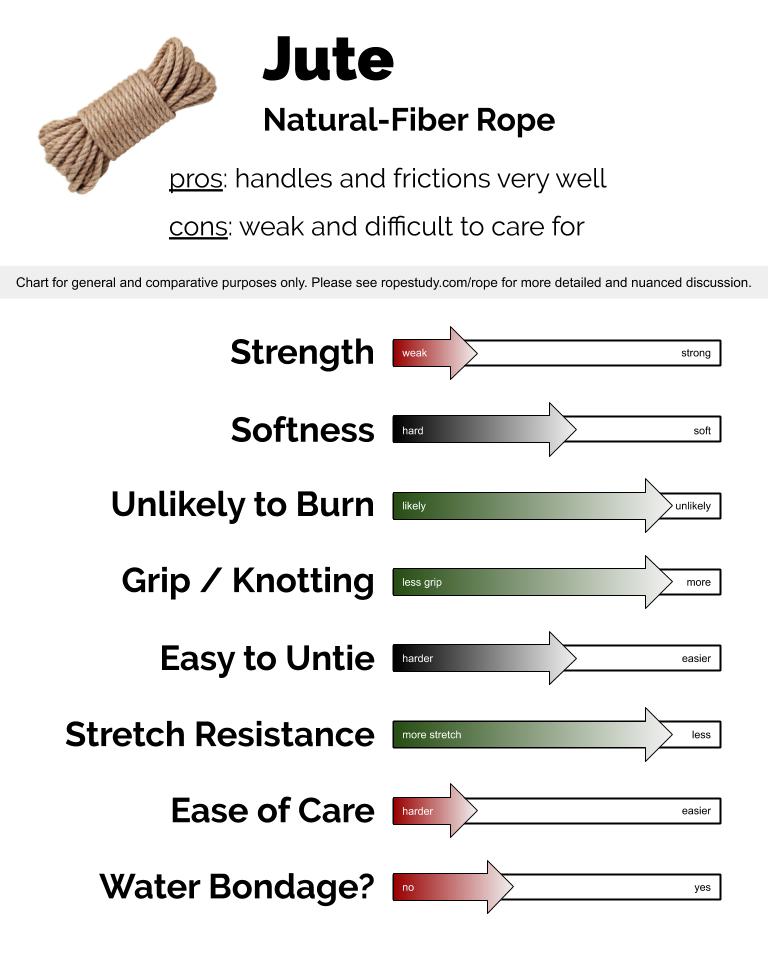
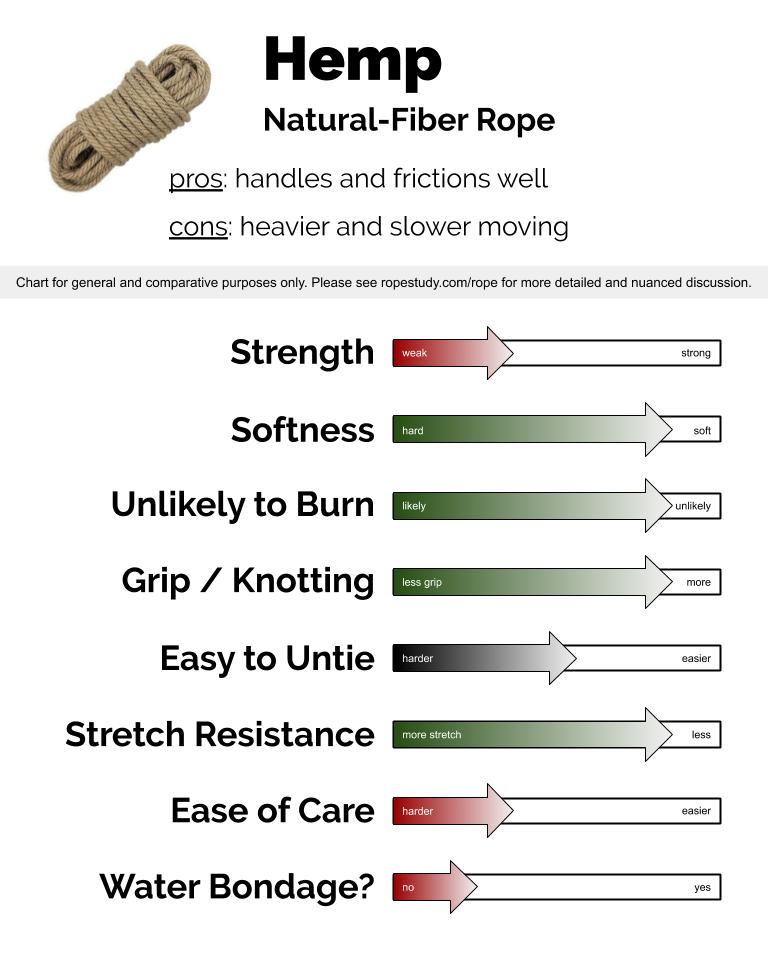
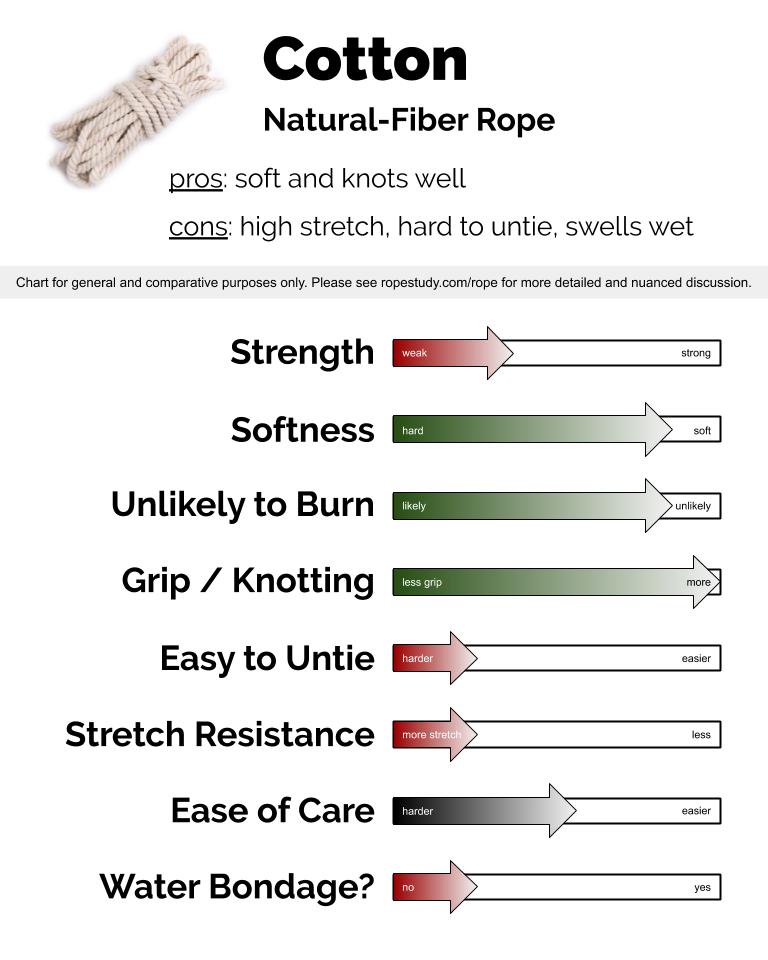
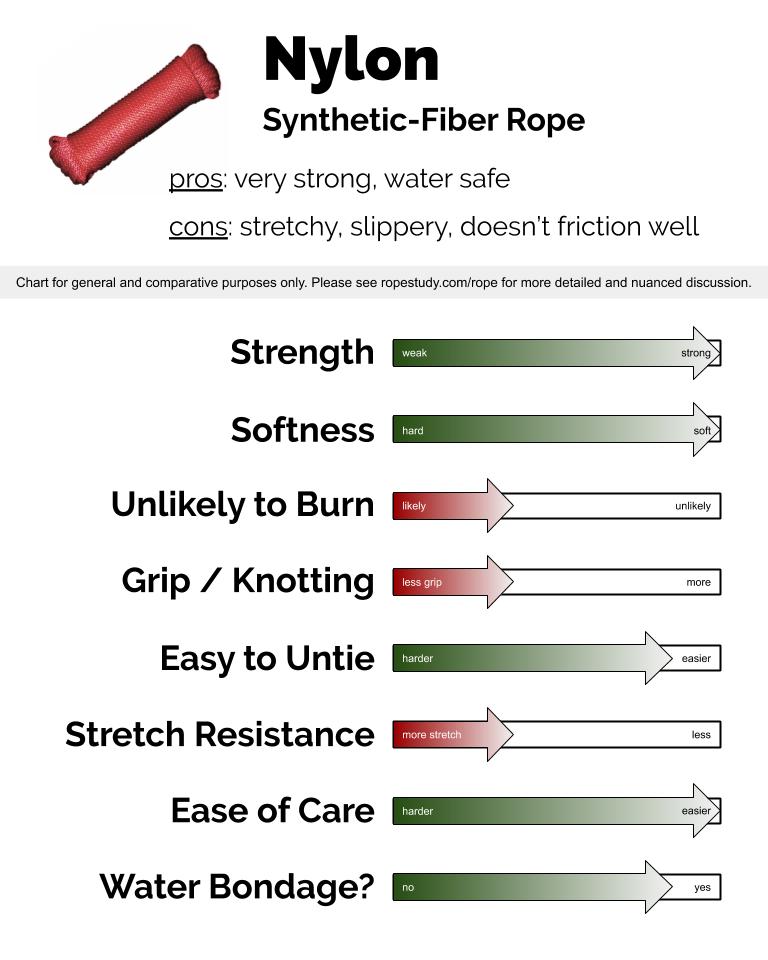
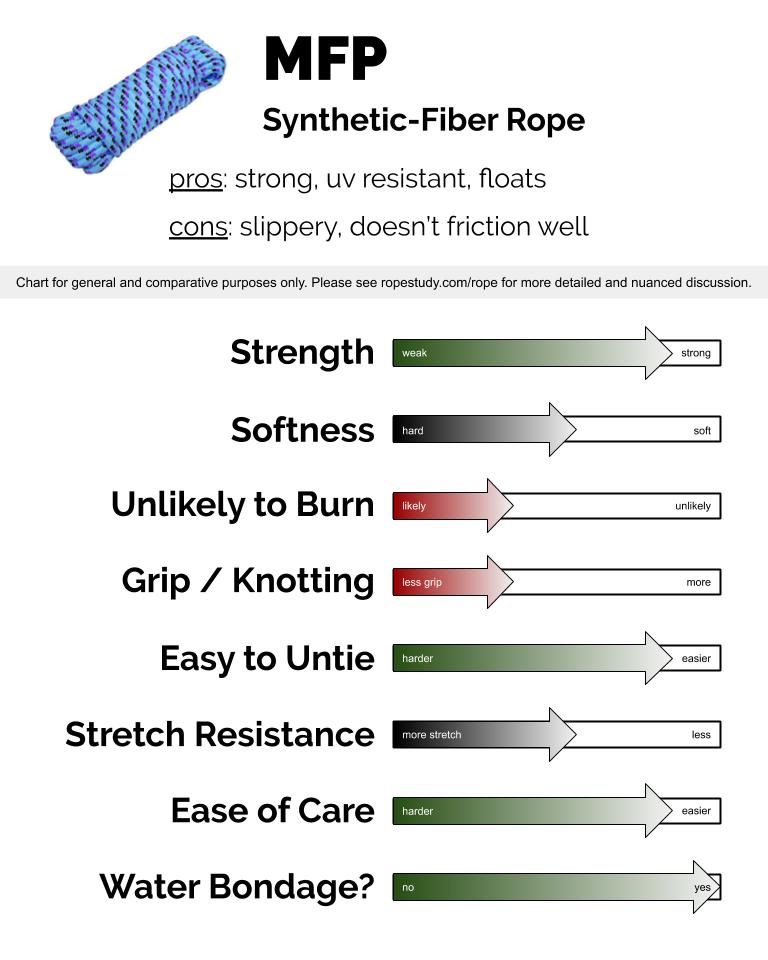
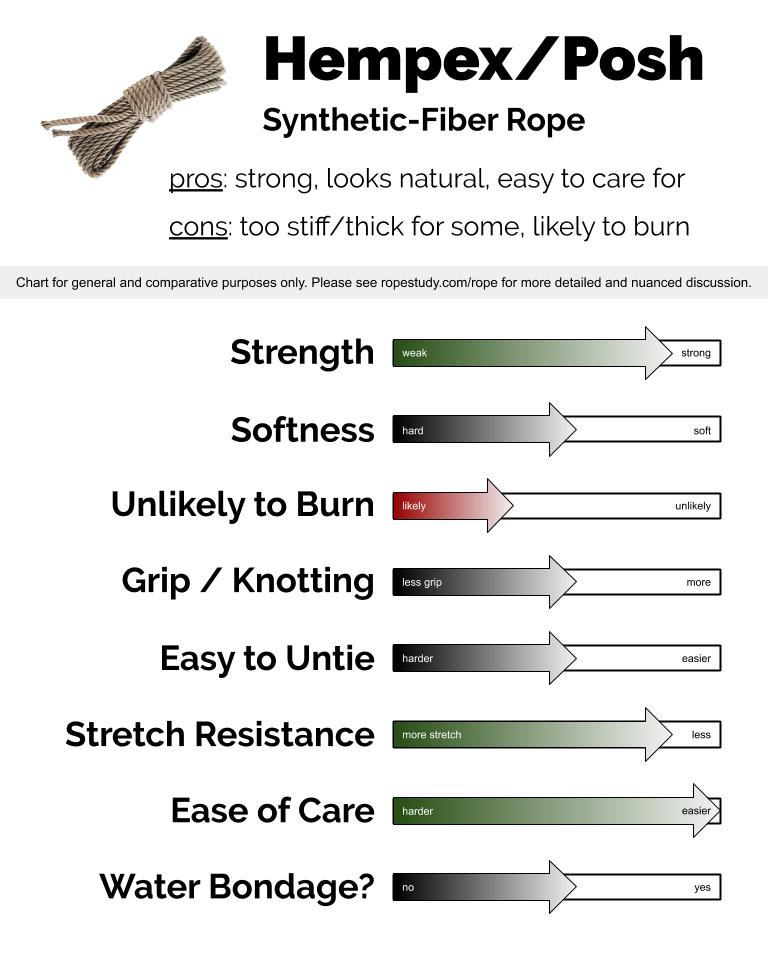
For a more detailed comparison of different bondage ropes, we recommend the chart on Crash-Restraint’s site: “Rope Material Selection“
Construction
As with everything else in this section, we have to speak in generalities, particularly when it comes to natural fiber rope, because there can be so much variation depending on the manufacturer.
In general, you’ll find two types of rope: twisted or braided. Natural fiber bondage rope is typically twisted while synthetic may be twisted or braided.
Twisted rope is usually made of three strands, and each strand is created by spinning together the yarns of the fiber making the rope. Single-ply rope is created by using single yarns, twisted together, to form each strand. Double-ply rope is created by first twisting together two single yarns and then twisting those “doubled-yarns” together to form the strands.
Single-ply rope tends to be more flexible and easier to work with and tends to make more compact frictions, but it’s more susceptible to wear. Double-ply rope is a little stiffer and bulkier, but also a little more durable.
Braided rope not specifically made for bondage tends to have a solid core of some type (either the same or different fiber). This core adds bulk and makes the rope less pliable. Many people remove this core before using the rope for bondage, which makes the rope easier to work with but can also weaken the rope to varying amounts.
Rope Ends
Rope ends can be finished with a number of different knots or other options, including:
- Knotted: the easiest and most common in natural fiber rope; often preferred because it makes joining ropes easier; common finishing knots include overhand, flat overhand, wall knot, Mathew Walker knot, and thistle knot.
- Whipped: twine is used to secure the end; makes it easier to pull rope through, but more difficult to join; often used for specialty rope, like thin detail rope for hair, etc.
- Taped: similar to whipped, but using tape to secure the ends; more often used on synthetic rope than natural fiber
- Fused: synthetic rope ends can be melted and fused together; similar advantages and disadvantages to whipped ends; sometimes combined with taped ends.
Size
Diameter
Typical bondage rope is between 5mm and 8mm in diameter, with 6mm being the most common. However, it’s worth noting that the diameter of natural fiber rope is usually more of an approximation.
While thinner ropes are more flexible, make more compact knots, and hold knots better, those knots are harder to untie and the rope bites into the skin more painfully, not to mention the weaker nature of thinner ropes. In contrast, thicker ropes are stronger and can be more comfortable, but the knots they form are bulkier and may come undone easier.
Length
Most rope made for bondage is sold in 7 or 8 meter lengths (23 to 26 feet). However, you can also order or make custom-length rope depending on your needs. One typical recommendation for rope length is “four arm-pulls” … in other words, if you measure your arm from armpit to fingertip, then multiply that distance by 4, that’s a good “ideal” rope length for the rope top. Another way to find an ideal length is to consider the size of the person or people being tied and the amount of rope required for the types of ties they’re used to. However, this isn’t always practical if you’re not making or cutting your own rope, as it often requires special orders (which can cost more).
Many rope tops prefer using ropes of the same length and simply joining additional ropes as needed. Shorter ropes mean joining more frequently, and longer ropes mean more rope to pull through for every move. However, shorter ropes can be handy for finishing a tie that only needs a little more rope to complete, and longer ropes can be useful for specific purposes or larger bodies.
Common Lengths:
- For the “main” ropes: 7-8 meters / 25 to 30 feet (these aren’t strictly equivalent measurements, but are typical lengths)
- For smaller ropes (for finishing, extending, etc.): 3-4 meters / 10 to 15 feet or shorter
Typical Number of Ropes:
- For beginners: 3 main ropes to start with is usually enough
- For intermediate: 6 main ropes and at least 1 smaller rope
- For advanced: 8+ main ropes and 2-5 smaller ropes
Rope & Style
One other thing to consider before paying much for rope is the style of rope you want to pursue. We considered these styles in an earlier lesson, but below are some quick notes on how three of these styles relate to rope selection. However, please note that there are no “rules” for which ropes “must” be used with any particular style … just common uses and preferences.
- Western – This type of rope work lends itself well to nylon, cotton, hemp, and other thicker, softer types of rope.
- Common Material: nylon, cotton, or hemp
- Common Size: 30+ feet (usually folded in half for use), 6-8+mm in diameter
- Japanese – This type of rope work lends itself well to jute and hemp (mainly because of the friction and grip of natural fiber rope), and typically avoids synthetic rope altogether.
- Common Material: jute or hemp
- Common Size: 20-30 feet (typically folded in half for use), 4-6mm in diameter (4mm usually referred to as “hojo” rope for specialized tying)
- Decorative – A wide range of different rope types might be used for this approach, though colored rope and rope of different sizes that allows for more detailed, intricate knots and patterns are typically preferred.
- Common Material: MFP, nylon, cotton
- Common Size: varies widely depending on the design of the decorative tie